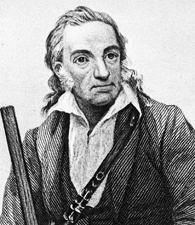Many a bird watcher will recognize the name of John James Audubon, the famous naturalist who made a name for himself by painting and describing many of America’s birds, and creating such notable works as “Birds of America.”
James Audubon’s Early Days
Audubon was born April 26, 1785, in Les Cayes, Saint-Domingue (present-day Haiti), the illegitimate son of French ship captain and slave trader Jean Audubon and his chambermaid, Jeanne Rabin. The child was known alternatively as Fougere Rabin, Jean Rabin, and Jean-Jacques Fougere Audubon, his baptismal name.
When he was three, Audubon was taken by his father to France, where he was raised primarily by his stepmother. From an early age, Audubon was interested in birds and drawing, and he claimed to have studied with the French painter Jacques-Louis David.
In 1803, to escape being drafted into Napoleon’s army, 18-year-old Audubon moved to the United States and adopted the anglicized named John James Audubon. He settled on a family-owned farm in Pennsylvania, where he was able to hunt and study birds while attempting to operate a mine. It was here that he met Lucy Bakewell, whom he married in 1808.
Sources in this Story
- The Handbook of Texas: Audubon, John James
- National Audubon Society: John James Audubon 1785-1851
- National Gallery of Art: John James Audubon
- Museum of Nebraska Art: John James Audubon (1785-1851)
- PBS: John James Audubon: Drawn from Nature
Audubon’s Notable Accomplishments
Audubon traveled long distances, looking for birds and drawing them in detail. He spent several years moving his family about as he pursued different business ventures, which all ended in failure.
After spending time in jail for debt in 1819, he began his ornithological career. He sailed down the Mississippi River with a young assistant named Joseph Mason and planned to publish his bird illustrations. He sought financial support for his project in Philadelphia, but after failing to attract any sponsorship there, he turned to England in 1826. After showing his work to the Royal Institution, Audubon found a group willing to help him start creating a book of bird illustrations.
“Birds of America,” which contained 435 engravings of 1,065 birds, is one of the most influential of Audubon’s works; according to the National Audubon Society, the book “is still a standard against which 20th and 21st century bird artists, such as Roger Tory Peterson and David Sibley, are measured.”
Audubon secured his place as one of the United States’ preeminent wildlife artists for decades. He drew many life-size portraits of birds, from hummingbirds to eagles, in poses intended to mimic how they appeared in the wild. With “Birds of America” and another publication, “The Viviparous Quadrupeds of North America,” Audubon successfully recovered from his financial difficulties of earlier years.
While Audubon is highly regarded as an artist, he must also be credited for his scientific observations. He conducted North America’s first bird-banding experiment. After tying strings on the legs of Eastern Phoebes, he concluded that the birds came back to the same nesting sites every year.
Audubon was a flamboyant figure who was prone to exaggeration for dramatic effect. He often drew birds in unrealistic poses or situations, made up stories of his adventures through the West, and claimed others’ work as his own. “A tenuous balance between fact and fiction runs through Audubon’s life and work,” says Audubon scholar Ella Foshay.
The Man and His Work
- “John James Audubon: The Making of an American” by Richard Rhodes
- “Audubon’s Birds Of America”
- “John James Audubon: Writings and Drawings”
The Rest of the Story
Audubon died in New York on January 27, 1851. His name lives thanks to naturalist George Bird Grinnell, who founded the conservationist National Audubon Society in 1886. Grinnell knew how much Audubon had toiled to preserve birds and their habitats, and found it fitting that the organization should bear the deceased’s name.
This article was originally written by Lindsey Chapman; it was updated March 27, 2017.











